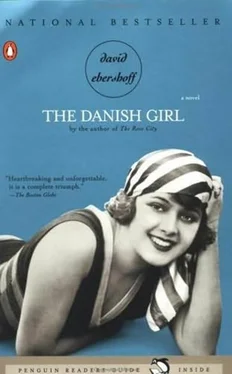Carlisle’s face was handsome and long, his hair less yellow-white than Greta’s and with more kink in the strand. He had never married, spending his evenings at his drafting table or in his oak rocker with a green-glass lamp pulled near for reading. There were girls, he reported to Greta in his letters, girls who joined his table at the Valley Hunt Club or who worked as assistants on his jobs, but no one who meant much. “I can wait,” he would write, and Greta would think, holding the letter in the sunlight at the window, So can I.
The spare bedroom in the casita had an iron bed and brocade wallpaper. There was a lamp with a fringed shade that Greta worried wouldn’t provide enough light. The charcuterie on the corner had lent her a zinc tub for the Epsom-and-white-wine balm; typically geese lay dead in it, their necks curled over its rim.
In the mornings Carlisle would take his coffee and croissant at the long table in the casita’s front room, his bad leg a thin rail in his pajamas. At first Einar would slip out of the apartment just as the knob on Carlisle’s door began to turn. Einar was timid around Carlisle, Greta noticed. He would quiet his step whenever he passed Carlisle’s door, as if to avoid a chance meeting in the hall, beneath the crystal-bowl lamp. At dinner, Einar’s shoulders would bunch up, as if it pained him trying to think of something to say. Greta wondered if something had passed between them, a harsh word, perhaps an insult. Something invisible seemed to be hanging between them, a thread of will that she couldn’t quite, at least not yet, understand.
Once, Carlisle invited Einar to a vapor bath on the rue des Mathurins. It wasn’t like the Bains du Pont-Solférino, out in the sunlight along the Seine. Instead, it was a pool for men in a gymnasium with steamy air and yellow marble tiles and palm trees drooping in Chinese cachepots. When Einar and Carlisle returned from the bath, Einar immediately locked himself in his room. “What happened?” Greta asked her brother. And Carlisle, whose eyes were red from the water, said, “Nothing. He just said he didn’t want to swim. Said he didn’t know you had to swim naked.” And then, “He nearly fainted at the sight of it. But hasn’t he ever been to a Turkish bath?”
“It’s the Dane in him,” Greta said, knowing it wasn’t true. Why, she thought, the Danes would look for any excuse to remove their clothes and prance around.
Shortly after Carlisle arrived, Hans stopped by one morning to look over Greta’s latest paintings. There were two to show him: the first was Lili, large and flat, on the beach in Bornholm; the second was Lili standing next to a Blood of China camellia tree. Einar had painted the sea in the background of the first, working steadily and tidily on its pale blue summer tide. The camellia tree, however, he couldn’t quite pull off, unfamiliar as he was with the puckering red blossoms and the buds as shiny and tight as acorns. She ’d taken on an assignment from Vogue -illustrating next winter’s fox-lined coats-and so the only time she had to finish the camellia portrait was in the middle of the night. For three nights she stayed up, delicately painting the bloom of petals in each flower, with the hint of sorbet-yellow at its center, while Einar and Carlisle slept, her studio silent except for Edvard IV’s occasional sigh.
She finished the painting only hours before Hans arrived to see it. “Still wet,” she said, serving him coffee, and a cup for Carlisle, another for Einar, who was fresh from a bath, his hair wet at the tips.
“It’s a good one,” Hans was saying, looking at the camellia painting. “Very Oriental. That’s what they like these days. Maybe you should try painting her in an embroidered kimono?”
“I don’t want to make her look cheap,” she said.
“Don’t do that,” Einar said, so quietly Greta wasn’t sure if the others had heard.
“That’s not what I meant,” Hans said. He was in a pale summer suit, his legs crossed, his fingers drumming the long table. Carlisle was on the velvet ottoman, Einar in the rocker. It was the first time the three men had been together, and Greta kept moving her eyes from her brother, with his leg up on the velvet cushion, to her husband, with the wet tips of his hair against his thin throat, to Hans. She felt as if she were a different person with each of them. As if she rolled out a different repartee for each of them; and maybe she did. She wondered if they felt that they knew her at all. Perhaps she could be wrong, but it was how she felt-as if each of them wanted something different from her.
Hans had respected her wishes, withdrawing his attention, remaining focused on selling her work. There were times, when they found themselves alone, in the back room of his office or in her studio while Lili was out, when Greta could feel his eyes on her. But when his back was turned she couldn’t help staring, at the spread of his shoulders, at the blond hair creeping over his collar. She knew what she was longing for, but she forced herself to shove it aside. “Not while Einar’s still…” In her chest she could feel the clamps closing with a clang. She expected those passions, such heartswell, from Lili. Not from herself, not anymore, not now, with a studio full of unfinished portraits and assignments from the magazines waiting to be drawn, and her light-stepped husband weak in body, confused in mind, and her brother showing up in Paris with his incomplete statement “I’ve come to help,” and Hans, at her long workman’s table, his long fingers drumming the pine top, waiting for the paint of the camellias to dry, waiting for a second cup of coffee, waiting for Greta to produce a painting of Lili in a kimono, waiting, patiently, with a flat brow, simply waiting for Greta to fall into his arms.
This was the household, then, her casita, from which Greta set out one afternoon that summer. It was hot, the black traffic exhaust hanging heavily. The sun was dull in a hazy sky, reducing the sparkle of the city. The beige front stone of the buildings looked soft, like warm cheese. Women walked with handkerchiefs, swabbing sweat from their throats.
The Métro was even hotter, its handrail sticky. It was only June, and she and Einar wouldn’t take their holiday in Menton for another several weeks. She wondered if she would make it-something about the summer would have to change, Greta told herself-but then the train scraped along its rails and stopped.
She emerged from the station in Passy, where the air felt cooler. There was a breeze, and a scent of cut lawn, and the trickle of a fountain. She heard the springy thud of a tennis ball landing on red clay. She heard someone beating a rug.
The apartment house was a former villa, built from yellow granite and copperwork. It had a little half-circle drive that was spotted with motor oil, and a sentry of rose trees clipped into tight pompoms. The front door was made of glass and ironwork. Above it was a terrace, its door open, a drape blowing. Greta heard a woman’s laugh, followed by a man’s.
Anna had rented the second-floor apartment. She was singing three nights of Carmen at the Palais Garnier; after her performance, she ’d eat a midnight supper of cold crab claw at Prunier’s. Lately she’d begun to swear she would never return to Copenhagen. “It ’s just too orderly for me,” she ’d say, a hand balled against her breast.
Anna answered the door. Her blond hair was tight in a bun at the nape of her neck. The skin in her throat seemed to be scarring into permanent brown lines where her folds of fat lay. She was wearing a large ruby cocktail ring, designed like an exploding star. She had made a name for herself in the opera world; skinny young men with deeply sunk eyes sent her unset gems, ginger-snap cookies, and nervously written cards.
Читать дальше












